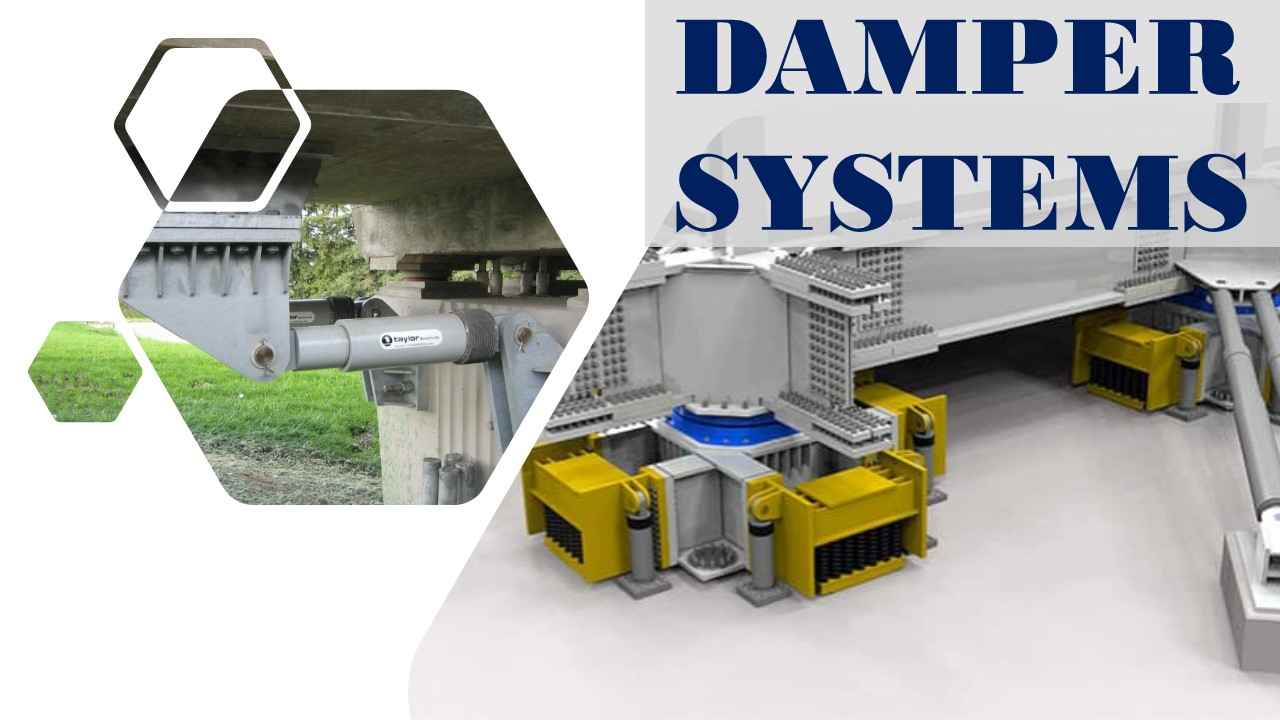Purpose of Damper System in Structure: To prevent the Collapse of Structure
- By
- Pooja |
- September 27, 2022 |
- Civil Engineering, Bridge Engineering, Building/ Structure Engineering,

Table of Contents
Introduction to Damper System in Structure
Shock Absorbing Qualities of the Structure
Introduction to Damper System in Structure
Dampers are used to decrease the lateral force induced by earthquakes while upgrading seismic structures. A great deal of force is exerted on a building during an earthquake. The structure absorbs or amortizes this energy in two forms:
- Kinetic and
- Strain
Vibration would be continuous if the structure had no damping; nevertheless, damping from the material reduces vibration. An earthquake's energy input to a structure is represented mathematically by the equation below:
E = Ek + Es + En + Ed....
There are four types of energy in this calculation:
- Earthquake input (E),
- Kinetic (Ek),
- Reversible strain (Es) in the elastic range (Eh),
- Amortized (Ed) energy
Energy dissipation systems have been given a unique role in seismic isolation systems. It is possible to increase damping by numerous techniques, such as using the flow of a soft material, two metals rubbing against each other, or a piston moving in a slimy fluid.
Shock Absorbing Qualities of the Structure
The structural reaction is reduced by damping up ( spurt and movement) dampening effect has no influence on spectrum quantity at low frequencies (near to zero) and has a low impact on response acceleration at high frequencies. Damping increases in frequency from 0.3 to 2.5 seconds have the greatest impact.
There is a range of dampers available on the market nowadays.
Dampers can be divided into metal (flowing), friction, viscoelastic, viscous, mass dampers and shape memory alloys (SMA). High energy absorption, ease of fitting and replacement, and cooperation with other structural elements are only a few of the benefits of employing dampers.
Anti-Friction Pads
Seismic energy is utilized to overcome friction on the contact surfaces for these types of dampers. The non-functioning dampers under the load prevent fatigue in served loads, and the damper's performance is independent of loading speed and ambient temperature, among other things. Parallel to the bracing, these dampers are inserted.
PVD Damper is a good example.
Because of their simplicity of installation, they are quite commonly utilized as friction dampers in construction. Flexible constructions, such as bending steel frames, can benefit from applying a PVD damper. Installing a metal skeleton brace can create the necessary dampening for PVD dampers.
The first structure to be planned by an Iranian architect and constructed employing PVD dampers from the Robinson business was a private residence with a floor space of 164/5 square meters and six stories.
Seismic dampers, a novel retrofitting technique, are being utilized in this structure to prepare for an earthquake. The total number of 100 KN PVD dampers is 12. Robinson firm dampers of 350, 600 and 850 KN PVD were used in a high-rise structure in northern Tehran created by another architect, which is currently in the ordering stage.
Mass Damper
Roller-like fulcrum holds the weight of the object. As a result, the mass can be transferred to the floor in a transfer-lateral motion. There are dampers and springs between the mass and the anchor units to the frame and floor, which is why they are situated relative to each other in the "opposite phase".
The structural lateral force is transmitted by these anchor pieces. A spring damper in bi-vertical directions is applied to make a bidirectional transfer damper. In addition, they allow for precise control of the movement of two separate vertical structures.
During the earthquake, a seismic isolator separates structures from large ground vibrations. This separation is placed between the topside of the structure and the lower side of that in bridges, as opposed to the foundation of a building. A large inertia force of the topside (plus deck weight) as well as its ease of use are the main reasons for this.
Seismic isolation's primary goal is to bring the essential frequency of a structure's vibration down to a level below that of the main earthquake energy. Increased structural vibration time and bridge distance from periods containing the principal earthquake energies can be achieved by using seismic isolation.
Seismic isolation reduces the amount of energy that can be absorbed by the base during an earthquake. As a further benefit, seismological isolation provides a means of wasteful energy consumption. As a result, only a small portion of the energy that is put into the building is squandered.
To put it another way, after the earthquake, just a few concentrated areas of damage and destruction will be left behind. Most structures' responses are reduced in earthquakes when they are designed with seismic.
Relative damping increases as the main period lengthens (energy dissipation).
A bridge's isolation goals are very different from those of a structure. Isolators are put in a building's structural parts to lessen the energy forces exerted on the topside and alleviate the structure's stress.
To limit the transferred energy force and shift the topside to the side structures, a separate bridge is equipped with a seismic isolation device (backpacks or base) that is fitted to retain the elements beneath isolators (e.g., backpacks and/ or base)
To maximise energy absorption, isolators are recommended in bridge design. This needs to employ isolators, and from this standpoint, LRB seismic isolator has an intrinsic property of 30% (independent of temperature, vibration frequency, and environmental conditions).
Because long-term loads and thermal settings are placed in the seismic isolator earlier to stability testing, the viewpoint of that resistance is also significantly bigger than exploitation forces. In addition, the stability of the isolator buckling is monitored in relation to these forces.
Gravity and lateral seismic loads are hence the guiding elements in the design process. As a result, increasing damping is the primary consideration when deciding between LRB and HDRB with damping of 30% and 10%, respectively, for bridges. In 1982, a natural rubber compound was produced by a Malaysian manufacturer's research institute in English.
There was no need to install an additional 10% damper because the intrinsic dampening was so great. An ultrafine carbon block, resins or oils, and other unique fillers make this rubber composite damper. As much as 20% damping in shear stress equal to 100% is possible.
Furthermore, damping with low stiffness has a significant impact on its lower limit, which is 10%. Systems with high stiffness (stiffness of 70-75%) have a shear model of 0.34 MPa (PSI 50), while the upper limit of that model is 1.4 MPa (Mpa) (PSI 200). No changes have been made to the vulcanised processes, pasting, or structure of isolators.
Please feel free to like, share and comment.
Admin, gcelab.com
Please see our Pillar Post to know why we founded gcelab.com.
Read More:

Pooja
Founder at gcelab.com, Pooja is an Entrepreneur unlocking human potential. Working in the Principles of Lean Start-up, Pooja believes in Transparency and User Happiness the most. Pooja’s background in teaching gives her a sophisticated grasp on even the most tedious aspect of course building. She is passionate about people who believe that good is not enough.
Previous Post
Scholarships for Civil Engineering Courses UK
Next Post

